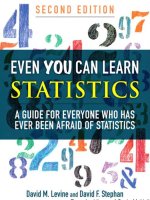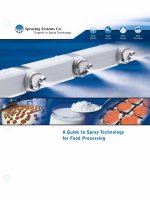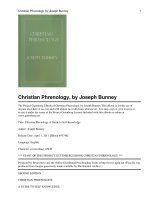excel 2010 for business statistics a guide to solving practical business problems
Bạn đang xem bản rút gọn của tài liệu. Xem và tải ngay bản đầy đủ của tài liệu tại đây (10.7 MB, 269 trang )
Excel 2010 for Business Statistics
Thomas Quirk
Excel 2010 for Business
Statistics
A Guide to Solving Practical
Business Problems
Thomas Quirk
School of Business and Technology
Webster University
470 Lockwood Avenue
St. Louis, Missouri 63119
USA
ISBN 978-1-4419-9933-7 e-ISBN 978-1-4419-9934-4
DOI 10.1007/978-1-4419-9934-4
Springer New York Dordrecht Heidelberg London
Library of Congress Control Number: 2011931529
# Springer Science+Business Media, LLC 2011
All rights reserved. This work may not be translated or copied in whole or in part without the written
permission of the publisher (Springer Science+Business Media, LLC, 233 Spring Street, New York,
NY 10013, USA), except for brief excerpts in connection with reviews or scholarly analysis. Use in
connection with any form of information storage and retrieval, electronic adaptation, computer software,
or by similar or dissimilar methodology now known or hereafter developed is forbidden.
The use in this publication of trade names, trademarks, service marks, and similar terms, even if they are
not identified as such, is not to be taken as an expression of opinion as to whether or not they are subject
to proprietary rights.
Printed on acid-free paper
Springer is part of Springer Science+Business Media (www.springer.com)
This book is dedicated to the more than 3,000 students
I have taught at Webster University’s campuses
in St. Louis, London, and Vienna; the students at
Principia College in Elsah, Illinois; and the students
at the Cooperative State University of
Baden-Wuerttemburg in Heidenheim, Germany.
These students taught me a great deal about the art
of teaching. I salute them all, and I thank them for
helping me to become a better teacher.
Excel 2010 for Business Statistics: A Guide to Solving Practical Business Problems
helps anyone who wants to learn the basics of appl ying Excel’s powerful statistical
tools to their business or to their classes. If understanding statistics isn’t your
strongest suit, you are not mathematically inclined, or you are wary of computers,
then this is the book for you.
You’ll learn how to perform key statistical tests in Excel without being over-
whelmed by statistical theory. This book clearly and logically shows how to run
statistical tests to solve practical business problems.
Excel is a widely available computer program for students, instructors, and
business managers. It is also an effective teaching and learning tool for quantitative
analyses in business courses. Its powerful computational ability and graphical
functions make learning statistics much easier than in years past. However, this is
the first book to showcase Excel’s usefulness in teaching business statistics, and
it focuses exclusively on this topic in order to render the subject matter applicable
and practical – and easy to comprehend and apply.
Unique features of this book:
l
Includes 165 color screen shots so you can be sure you are performing Excel
steps correctly.
l
You will be told each step of the way, not only how to use Excel, but also why
you are doing each step.
l
Includes specific objectives embedded in the text for each concept, so you can
know the purpose of the Excel steps.
l
You will learn both how to write statistical formul as using Excel and how to use
Excel’s drop-down menus that will create the formulas for you.
l
Statistical theory and formulas are explained in clear language without bogging
you down in mathematical fine points.
l
Practical examples of problems are taken from several functional areas of
business, including marketing, management, human resources, and production.
vii
l
Each chapter presents key steps to solve practical business problems using Excel.
In addition, three practice problems at the end of each chapter enable you to test
your new knowledge. Answers to these problem s appear in Appendix A.
l
A “Practice Test” is given in Appendix B to test your know ledge at the end of
the book. Answers to this test appear in Appendix C.
l
This book does not come with a CD of Excel files which you can upload to your
computer. Instead, you’ll be shown how to create each Excel file yourself.
In business, your colleagues will not give you an Excel file. You will be expected
to create your own. This book will give you ample practice in developing this
important skill.
l
This book is a tool that can be used either by itself or along with any good
statistics book.
This book is appropriate for use in any course – graduate of undergraduate – in
business statistics, as well as for managers who want to improve their Excel skills.
It will also benefit students who are taking courses in psychology, education,
sociology, or computer science who want to learn how to use Excel to solve
statistics problems.
The ideas in this book have been thoroughly tested by its author, Professor
Tom Quirk, in marketing statistics and marketing research courses. Prof. Quirk
has written more than 60 textbook supplements in management and marketing,
published more than 20 articles in professional journals, and presented more than
20 papers at professional meetings. He holds a B.S. in mathematics from John Carroll
University, both an M.A. in education and a Ph.D. in educational psychology from
Stanford University, and an M.B.A. from the University of Missouri, St. Louis.
St. Louis, Missour i Thomas Quirk
viii Preface
Acknowledgements
Excel 2010 for Business Statistics: A Guide to Solving Practical Business Problems
is the result of inspiration from three important people: my two daughters and
my wife. Jennifer Quirk McLaughlin invited me to visit her M.B.A. classes several
times at the University of Witwatersrand in Johannesburg, South Africa. These
visits to a first-rate M.B.A. program convinced me there was a need for a book to
teach students how to solve practical business problems using Excel. Meghan
Quirk-Horton’s dogged dedication to learning the many statistical techniques
needed to complete her Ph.D. dissertation illustrated the need for a statistics book
that would make this daunting task more user-friendly. And Lynne Buckley-Quirk
was the number-one cheerleader for this project from the beginning, always
encouraging me and helping me remain dedicated to completing it.
Sue Gold, a reference librarian at Webster University in St. Louis, was a
valuable colleague in helping me to do key research – and was a steady supporter
of this idea. Brad Wolaver of Webster University improved my Office 2010 skills in
many ways.
Kathryn Schell at Springer guided this book through the production process and
was a pleasure to work with. Marc Strauss, my editor at Springer, caught the spirit
of this idea in our first phone conversation and shepherded this book through the
idea stages until it reached its final form. His encouragement and support were vital
to this book seeing the light of day. I thank him for being such an outstanding
product champion throughout this process.
ix
1 Sample Size, Mean, Standard Deviation, and Standard Error
of the Mean 1
1.1 Mean. . . . . . . . . . . . . . . . . . . . . . . . . . . . . . . . . . . . . . . . . . . . . . . . . . . . . . . . . . . . . 1
1.2 Standard Deviation . . . . . . . . . . . . . . . . . . . . . . . . . . . . . . . . . . . . . . . . . . . . . . . 2
1.3 Standard Error of the Mean . . . . . . . . . . . . . . . . . . . . . . . . . . . . . . . . . . . . . . . 3
1.4 Sample Size, Mean, Standard Deviation, and Standard Error
of the Mean . . . . . . . . . . . . . . . . . . . . . . . . . . . . . . . . . . . . . . . . . . . . . . . . . . . . . . 4
1.4.1 Using the Fill/Series/Columns Commands 4
1.4.2 Changing the Width of a Column 5
1.4.3 Centering Information in a Range of Cells 6
1.4.4 Naming a Range of Cells 8
1.4.5 Finding the Sample Size Using the ¼COUNT Function 9
1.4.6 Finding the Mean Score Using the ¼AVERAGE
Function 10
1.4.7 Finding the Standard Deviation Using the ¼STDEV
Function 10
1.4.8 Finding the Standard Error of the Mean 10
1.5 Saving a Spreadsheet . . . . . . . . . . . . . . . . . . . . . . . . . . . . . . . . . . . . . . . . . . . . . 13
1.6 Printing a Spreadsheet . . . . . . . . . . . . . . . . . . . . . . . . . . . . . . . . . . . . . . . . . . . . 14
1.7 Formatting Numbers in Currency Format (2 Decimal Places) . . . . . . . 15
1.8 Formatting Numbers in Number Format (3 Decimal Places) . . . . . . . . 17
1.9 End-of-Chapter Practice Problems . . . . . . . . . . . . . . . . . . . . . . . . . . . . . . . . . 17
Reference. . . . . . . . . . . . . . . . . . . . . . . . . . . . . . . . . . . . . . . . . . . . . . . . . . . . . . . . . . . . . . 20
2 Random Number Generator 21
2.1 Creating Frame Numbers for Generating Random Numbers . . . . . . . . 21
2.2 Creating Random Numbers in an Excel Worksheet. . . . . . . . . . . . . . . . . 25
2.3 Sorting Frame Numbers into a Random Sequence . . . . . . . . . . . . . . . . . . 27
xi
2.4 Printing an Excel File So That All of the Information
Fits onto One Page . . . . . . . . . . . . . . . . . . . . . . . . . . . . . . . . . . . . . . . . . . . . . . . . 31
2.5 End-of-Chapter Practice Problems . . . . . . . . . . . . . . . . . . . . . . . . . . . . . . . . . 35
Reference. . . . . . . . . . . . . . . . . . . . . . . . . . . . . . . . . . . . . . . . . . . . . . . . . . . . . . . . . . . . . . 36
3 Confidence Interval About the Mean Using the TINV Function
and Hypothesis Testing 37
3.1 Confidence Interval About the Mean. . . . . . . . . . . . . . . . . . . . . . . . . . . . . . . 37
3.1.1 How to Estimate the Population Mean 37
3.1.2 Estimating the Lower Limit and the Upper Limit
of the 95% Confidence Interval About the Mean 38
3.1.3 Estimating the Confidence Interval for the Chevy
Impala in Miles Per Gallon 39
3.1.4 Where Did the Number “1.96” Come From? 40
3.1.5 Finding the Value for t in the Confidence
Interval Formula 40
3.1.6 Using Excel’s TINV Function to Find the Confidence
Interval About the Mean 41
3.1.7 Using Excel to Find the 95% Confidence Interval
for a Car’s Miles Per Gallon Claim . . 42
3.2 Hypothesis Testing . . . . . . . . . . . . . . . . . . . . . . . . . . . . . . . . . . . . . . . . . . . . . . . 48
3.2.1 Hypotheses Always Refer to the Population of People
or Events That You Are Studying 48
3.2.2 The Null Hypothesis and the Research (Alternative)
Hypothesis 49
3.2.3 The Seven Steps for Hypothesis-Testing Using the
Confidence Interval About the Mean . . 52
3.3 Alternative Ways to Summarize the Result
of a Hypothesis Test . . . . . . . . . . . . . . . . . . . . . . . . . . . . . . . . . . . . . . . . . . . . . . 58
3.3.1 Different Ways to Accept the Null Hypothesis 59
3.3.2 Different Ways to Reject the Null Hypothesis 59
3.4 End-of-Chapter Practice Problems . . . . . . . . . . . . . . . . . . . . . . . . . . . . . . . . . 60
References . . . . . . . . . . . . . . . . . . . . . . . . . . . . . . . . . . . . . . . . . . . . . . . . . . . . . . . . . . . . . 65
4 One-Group t-Test for the Mean 67
4.1 The Seven Steps for Hypothesis-Testing Using
the One-Group t-Test . . . . . . . . . . . . . . . . . . . . . . . . . . . . . . . . . . . . . . . . . . . . . 67
4.1.1 Step 1: State the Null Hypothesis and the Research
Hypothesis 68
4.1.2 Step 2: Select the Appropriate Statistical Test 68
4.1.3 Step 3: Decide on a Decision Rule
for the One-Group t-Test 68
4.1.4 Step 4: Calculate the Formula
for the One-Group t-Test 69
4.1.5 Step 5: Find the Critical Value of t in the t-Table
in Appendix E 70
xii Contents
4.1.6 Step 6: State the Result of Your Statistical Test 71
4.1.7 Step 7: State the Conclusion of Your Statistical
Test in Plain English! 71
4.2 One-Group t-Test for the Mean. . . . . . . . . . . . . . . . . . . . . . . . . . . . . . . . . . 71
4.3 Can You Use Either the 95% Confidence Interval
About the Mean OR the One-Group t-Test
When Testing Hypotheses?. . . . . . . . . . . . . . . . . . . . . . . . . . . . . . . . . . . . . . 76
4.4 End-of-Chapter Practice Problems . . . . . . . . . . . . . . . . . . . . . . . . . . . . . . . 76
References . . . . . . . . . . . . . . . . . . . . . . . . . . . . . . . . . . . . . . . . . . . . . . . . . . . . . . . . . . . 80
5 Two-Group t-Test of the Difference of the Means
for Independent Groups 81
5.1 The Nine Steps for Hypothesis-Testing Using
the Two-Group t- Test . . . . . . . . . . . . . . . . . . . . . . . . . . . . . . . . . . . . . . . . . . . 82
5.1.1 Step 1: Name One Group, Group 1,
and the Other Group, Group 2 82
5.1.2 Step 2: Create a Table That Summarizes
the Sample Size, Mean Score, and Standard Deviation
of Each Group 82
5.1.3 Step 3: State the Null Hypothesis and the Research
Hypothesis for the Two-Group t-Test . 83
5.1.4 Step 4: Select the Appropriate Statistical Test 84
5.1.5 Step 5: Decide on a Decision Rule
for the Two-Group t-Test 84
5.1.6 Step 6: Calculate the Formula
for the Two-Group t-Test 84
5.1.7 Step 7: Find the Critical Value of t in the t-table
in Appendix E 84
5.1.8 Step 8: State the Result of Your Statistical Test 86
5.1.9 Step 9: State the Conclusion of Your Statistical Test
in Plain English! 86
5.2 Formula #1: Both Groups Have More Than
30 People in Them. . . . . . . . . . . . . . . . . . . . . . . . . . . . . . . . . . . . . . . . . . . . . . 90
5.2.1 An example of Formula #1
for the Two-Group t-test 91
5.3 Formula #2: One or Both Groups Have Less Than
30 People in Them. . . . . . . . . . . . . . . . . . . . . . . . . . . . . . . . . . . . . . . . . . . . . . 97
5.4 End-of-Chapter Practice Problems . . . . . . . . . . . . . . . . . . . . . . . . . . . . . . . 103
References . . . . . . . . . . . . . . . . . . . . . . . . . . . . . . . . . . . . . . . . . . . . . . . . . . . . . . . . . . . 107
6 Correlation and Simple Linear Regression 109
6.1 What Is a “Correlation?” . . . . . . . . . . . . . . . . . . . . . . . . . . . . . . . . . . . . . . . . 109
6.1.1 Understanding the Formula for Computing
a Correlation 114
6.1.2 Understanding the Nine Steps for Computing
a Correlation, r 114
Contents xiii
6.2 Using Excel to Compute a Correlation Between
Two Variables . . . . . . . . . . . . . . . . . . . . . . . . . . . . . . . . . . . . . . . . . . . . . . . . . . 116
6.3 Creating a Chart and Drawing the Regression
Line onto the Chart . . . . . . . . . . . . . . . . . . . . . . . . . . . . . . . . . . . . . . . . . . . . . 120
6.3.1 Using Excel to Create a Chart and the Regression
Line Through the Data Points 121
6.4 Printing a Spreadsheet So That the Table and Chart Fit
onto One Page . . . . . . . . . . . . . . . . . . . . . . . . . . . . . . . . . . . . . . . . . . . . . . . . . . 130
6.5 Finding the Regression Equation . . . . . . . . . . . . . . . . . . . . . . . . . . . . . . . . 132
6.5.1 Installing the Data Analysis ToolPak into Excel 132
6.5.2 Using Excel to Find the SUMMARY OUTPUT
of Regression 134
6.5.3 Finding the Equation for the Regression Line 139
6.5.4 Using the Regression Line to Predict the y-Value
for a Given x-Value 139
6.6 Adding the Regression Equation to the Chart . . . . . . . . . . . . . . . . . . . . 140
6.7 How to Recognize Negative Correlations in the SUMMARY
OUTPUT Table . . . . . . . . . . . . . . . . . . . . . . . . . . . . . . . . . . . . . . . . . . . . . . . . 142
6.8 Printing Only Part of a Spreadsheet Instead of the Entire
Spreadsheet . . . . . . . . . . . . . . . . . . . . . . . . . . . . . . . . . . . . . . . . . . . . . . . . . . . . 144
6.8.1 Printing Only the Table and the Chart
on a Separate Page 144
6.8.2 Printing Only the Chart on a Separate Page 145
6.8.3 Printing Only the SUMMARY OUTPUT
of the Regression Analysis on a Separate Page 145
6.9 End-of-Chapter Practice Problems . . . . . . . . . . . . . . . . . . . . . . . . . . . . . . . 146
References . . . . . . . . . . . . . . . . . . . . . . . . . . . . . . . . . . . . . . . . . . . . . . . . . . . . . . . . . . . 151
7 Multiple Correlation and Multiple Regression 153
7.1 Multiple Regression Equation . . . . . . . . . . . . . . . . . . . . . . . . . . . . . . . . . . . 153
7.2 Finding the Multiple Correlation and the Multiple
Regression Equation . . . . . . . . . . . . . . . . . . . . . . . . . . . . . . . . . . . . . . . . . . . . 155
7.3 Using the Regression Equation to Predict Annual Sales. . . . . . . . . . . 159
7.4 Using Excel to Create a Correlation Matrix
in Multiple Regression . . . . . . . . . . . . . . . . . . . . . . . . . . . . . . . . . . . . . . . . . . 160
7.5 End-of-Chapter Practice Problems . . . . . . . . . . . . . . . . . . . . . . . . . . . . . . . 164
References . . . . . . . . . . . . . . . . . . . . . . . . . . . . . . . . . . . . . . . . . . . . . . . . . . . . . . . . . . . 168
8 One-Way Analysis of Variance (ANOVA) 169
8.1 Using Excel to Perform a One-Way Analysis
of Variance (ANOVA) . . . . . . . . . . . . . . . . . . . . . . . . . . . . . . . . . . . . . . . . . . 171
8.2 How to Interpret the ANOVA Table Correctly . . . . . . . . . . . . . . . . . . . 173
8.3 Using the Decision Rule for the ANOVA t-Test. . . . . . . . . . . . . . . . . . 174
xiv Contents
8.4 Testing the Difference Between Two Groups Using
the ANOVA t-Test. . . . . . . . . . . . . . . . . . . . . . . . . . . . . . . . . . . . . . . . . . . . . . 175
8.4.1 Comparing Dierberg’s vs. Shop ‘n Save in Their Prices
Using the ANOVA t-Test 176
8.5 End-of-Chapter Practice Problems . . . . . . . . . . . . . . . . . . . . . . . . . . . . . . . 180
References . . . . . . . . . . . . . . . . . . . . . . . . . . . . . . . . . . . . . . . . . . . . . . . . . . . . . . . . . . . 187
Appendix A: Answers to End-of-Chapt er Practice Problems 189
Appendix B: Practice Test 223
Appendix C: Answers to Practice Test 237
Appendix D: Statistical Formulas 247
Appendix E: t‐ Table 249
Index 251
Contents xv
Sample Size, Mean, Standard Deviation,
and Standard Error of the Mean
This chapter deals with how you can use Excel to find the average (i.e., “mean”)
of a set of scores, the standard deviation of these scores (STDEV), and the standard
error of the mean (s.e.) of these scores. All three of these statistics are used
frequently and form the basis for additional statistical tests.
1.1 Mean
The mean is the “arithmetic average” of a set of scores. When my daughter was in
the fifth grade, she came home from school with a sad face and said that she didn’t
get “average s.” The book she was using described how to find the mean of a set of
scores, and so I said to her:
“Jennifer, you add up all the scores and divide by the number of numbers that you
have.”
She gave me “that look,” and said: “Dad, this is serious!” She thought I was teasing
her. So I said:
“See these numbers in your book; add them up. What is the answer?” (She did that.)
“Now, how many numbers do you have?” (She answered that question.)
“Then, take the number you got when you added up the numbers, and divide that
number by the number of numbers that you have.”
She did that, and found the correct answer. You will use that same reasoning now,
but it will be much easier for you because Excel will do all of the steps for you.
We call this average of the scores the “mean,” which we symbolize as:
X, and we
pronounce it as: “Xbar.”
T. Quirk, Excel 2010 for Business Statistics: A Guide to Solving Practical
Business Problems, DOI 10.1007/978-1-4419-9934-4_1,
#
Springer Science+Business Media, LLC 2011
1
The formula for finding the mean with your calculator looks like this:
X ¼
P
X
n
(1.1)
The symbol S is the Greek letter sigma, which stands for “sum.” It tells you to
add up all the scores that are indicated by the letter X, and then to divide your
answer by n (the number of numbers that you have).
Let’s give a simple example:
Suppose that you had these six scores:
6
4
5
3
2
5
To find the mean of these scores, you add them up, and then divide by the
number of scores. So, the mean is: 25/6 ¼ 4.17
1.2 Standard Deviation
The standard deviation tells you “how close the scores are to the mean.” If the
standard deviation is a small number, this tells you that the scores are “bunched
together” close to the mean. If the standard deviation is a large number, this tells
you that the scores are “spread out” a greater distance from the mean. The formula
for the standard deviation (which we will call STDEV) and use the letter, S,
to symbolize is:
STDEV ¼ S ¼
ffiffiffiffiffiffiffiffiffiffiffiffiffiffiffiffiffiffiffiffiffiffiffiffi
P
ðX À
XÞ
2
n À1
s
(1.2)
The formula look complicated, but what it asks you to do is this:
1. Subtract the mean from each score (X À
X).
2. Then, square the resulting number to make it a positive number.
3. Then, add up these squared numbers to get a total score.
4. Then, take this total score and divide it by n À 1 (where n stands for the number
of numbers that you have).
5. The final step is to take the square root of the number you found in step 4.
2 1 Sample Size, Mean, Standard Deviation, and Standard Error of the Mean
You will not be asked to compute the standard deviation using your calculator in
this book, but you could see examples of how it is computed in any basic statistics
book. Instead, we will use Excel to find the standard deviation of a set of scores.
When we use Excel on the six numbers we gave in the description of the mean
above, you will find that the STDEV of these numbers, S, is 1.47.
1.3 Standard Error of the Mean
The formula for the standard error of the mean (s.e., which we will use S
X
to
symbolize) is:
s:e: ¼ S
X
¼
S
ffiffiffi
n
p
(1.3)
To find s.e., all you need to do is to take the standard deviation, STDEV, and
divide it b y the square root of n, where n stands for the “number of numbers” that
you have in your data set. In the example under the standard deviation description
above, the s.e. ¼ 0.60. (You can check this on your calculator.)
If you want to learn more about the standard deviation and the standard error of
the mean, see Weiers (2011).
Now, let’s learn how to use Excel to find the sample size, the mean, the standard
deviation, and the standard error or the mean using a problem from sales:
Suppose that you wanted to estimate the first-year sales of a new product that
your company was about to launch into the marketplace. You have decided to look
at the first-year sales of similar products that your company has launched to get an
idea of what sales are typical for your new product launches.
You decide to use the first-year sales of a similar product over the past 8 years,
and you have created the table in Fig. 1.1:
Note that the first-year sales are in thousands of dollars ($000), so 10 means that
the first-year sales of that product were really $10,000.
Fig. 1.1 Worksheet data for
First-year sales (practical
example)
1.3 Standard Error of the Mean 3
1.4 Sample Size, Mean, Standard Deviation,
and Standard Error of the Mean
Objective: To find the sample size (n), mean, standard deviation (STDEV),
and standard error of the mean (s.e.) for these data
Start your computer, and click on the Excel 2010 icon to open a blank Excel
spreadsheet.
Enter the data in this way:
A3: Year
B3: First-year sales ($000)
A4: 1
1.4.1 Using the Fill/Series/Columns Commands
Objective: To add the years 2–8 in a column underneath year 1
Put pointer in A4
Home (top left of screen)
Fill (top right of screen: click on the down arrow; see Fig. 1.2)
Fig. 1.2 Home/Fill/Series commands
4 1 Sample Size, Mean, Standard Deviation, and Standard Error of the Mean
Series
Columns
Step value: 1
Stop value: 8 (see Fig. 1.3)
The years should be identified as 1–8, with 8 in cell A11.
Now, enter the first-year sales figures in cells B4: B11 using the above table.
Since your computer screen shows the information in a format that does not
look professional, you need to learn how to “widen the column width” and how
to “center the information” in a group of cells. Here is how you can do those
two steps:
1.4.2 Changing the Width of a Column
Objective: To make a column width wider so that all of the information fits
inside that column
If you look at your computer screen, you can see that Column B is not wide enough
so that all of the information fits inside this column. To make Column B wider:
Click on the letter, B, at the top of your computer screen
Place your mouse pointer at the far right corner of B until you create a “cross sign”
on that corner
Fig. 1.3 Example of dialogue box for Fill/Series/Columns/Step value/Stop value commands
OK
1.4 Sample Size, Mean, Standard Deviation, and Standard Error of the Mean 5
Left-click on your mouse, hold it down, and move this corner to the right until it is
“wide enough to fit all of the data”
Take your finger off the mous e to set the new column width (see Fig. 1.4)
Then, click on any empty cell (i.e., any blank cell) to “deselect” column B so that it
is no longer a darker color on your screen.
When you widen a column, you will make all of the cells in all of the rows of this
column that same width.
Now, let’s go through the steps to center the information in both Column A and
Column B.
1.4.3 Centering Information in a Range of Cells
Objective: To center the information in a group of cells
In order to make the information in the cells look “more professional,” you can
center the information using the following steps:
Left-click your mouse on A3 and drag it to the right and down to highlight cells A3:
B11 so that these cells appear in a darker color
At the top of your computer screen, you will see a set of “lines” in which all of the
lines are “centered” to the same width under “Alignment” (it is the second icon
at the bottom left of the Alignment box; see Fig. 1.5)
Fig. 1.4 Example of how to
widen the column width
6 1 Sample Size, Mean, Standard Deviation, and Standard Error of the Mean
Click on this icon to center the information in the selected cells (see Fig. 1.6)
Fig. 1.5 Example of how to center information within cells
Fig. 1.6 Final result of centering information in the cells
1.4 Sample Size, Mean, Standard Deviation, and Standard Error of the Mean 7
Since you will need to refer to the first-year sales figures in your formulas, it will
be much easier to do this if you “name the range of data” with a name instead of
having to remember the exact cells (B4: B11) in which these figures are located.
Let’s call that group of cells Product, but we could give them any name that you
want to use.
1.4.4 Naming a Range of Cells
Objective: To name the range of data for the first-year sales figures with the
name: Product
Highlight cells B4: B11 by left-clicking your mouse on B4 and dragging it down
to B11
Formulas (top left of your screen)
Define Name (top center of your screen)
Product (type this name in the top box; see Fig. 1.7)
Fig. 1.7 Dialogue box for “naming a range of cells” with the name: Product
OK
8 1 Sample Size, Mean, Standard Deviation, and Standard Error of the Mean









![cruising alaska [electronic resource] a guide to the ports of call.](https://media.store123doc.com/images/document/14/y/ba/medium_bal1401351374.jpg)